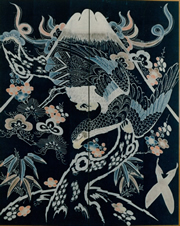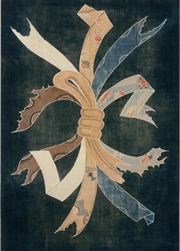Producer of Aizome/indigo-dyed items originating from Japan

It all started from an old strip of 'Tsutsugaki' cloth.
"Tsutsugaki"(freehand paste-resist indigo dyeing), the popularity of which peaked during the Edo period, has bequeathed us particular traditional patterns and designs that still surface on old cloths even now. At Genshodo, we strive to reproduce such diversified patterns by expressing them on various articles, in the hope of further expanding valuable knowledge and transmitting details of such patterns for posterity.
The " Tsutsugaki"dyeing technique can be seen on cloths dating back to the Nara period (AD710-794), but is believed to have been established in the mid-Edo period. The technique involves several processes, but centres on a rough sketch drawn on a white cloth. Rice paste as resist paste is squeezed from a holder made of tanned paper onto a design which has previously been drawn onto the fabric. After it has completely dried out, the cloth is then immersed in an indigo dye bath for dyeing. If some portion needs to remain a lighter shade, rice paste is applied throughout the non-dyeing area, thus preventing the colour from penetrating. When the rice paste is washed out, the shading differences in terms of light/dark ranges can be obtained to round off the design, while embellishing it with more colours involves subsequent acquisition of red or green pigment. Unlike stencil dyeing, the rough sketches involved are drawn freehand, even with rice paste. This means no two designs are ever exactly the same and is considered one of the greatest features of "Tsutsugaki" Since the process of immersing indigo in the dyeing liquid and drying the material is repeated numerous times to apply darker shades, the paste used for batik or "yuzen"dyeing is deemed unsuitable while that made of glutinous rice was the only resist paste adapted for indigo dyeing.
The < Sumptuary Edict> established during the Edo period involved a ban on luxuries for ordinary people, namely limiting the usage of cloth to 'cotton' and enforcing the application of the"indigo blue"colour. However this restriction is likely to have catalysed the "Tsutsugaki ai-momen" which retains characteristics of abundant humorous intimacy and spontaneous splendour. Many of the "Tsutsugaki"designs reflecting particular regional patterns were used in articles of the trousseau or furoshiki for celebration; all of which made with auspicious motifs and wishes for posterity.
"Tsutsugaki Ai-momen" ... a work in which all possible expertise converges; masterfully reflecting the emotion of the clients and enveloped in the sensitive resonance of all the craftsmen involved. Although most of the original Tsutsugaki works have been owned by collectors and have hence almost vanished from view, we are delighted to give you this opportunity to get up close to such classic Japanese ordinary culture in the form of our Genshodo Aimomen reproductions, handed down by our great predecessors.


